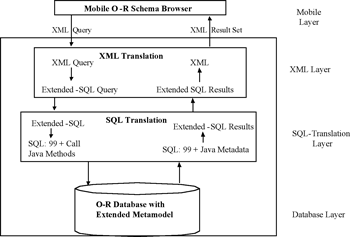|
|||
|
 |
| Mobile Object-Relational Schema Browser. |
Mobile Layer
The Figure illustrates the deployment architecture for O-R metadata access. In the Mobile Layer, a PDA uses the metadata middleware in a specific application. The Schema Browser queries the schema using the Extended-SQL metadata query language, developed by the Interoperable Systems Group (ISG). This includes metadata query options for any O-R schema, role views and multimedia objects. The extended-SQL queries are wrapped in XML to provide a robust, non-proprietary, persistent and verifiable file format for the storage and transmission of data. Using the XML version of the language, the Schema Browser automatically queries and displays the complex metadata required to display the O-R schema model.
XML Translation Layer
The XML Translation Layer resides at the database server. Its purpose is to provide a standard interface to the Extended-SQL query language. When receiving a query it is unwrapped to form an Extended-SQL query, which is subsequently passed to the SQL translation layer. After execution, results received from the SQL Translation Layer are XML-wrapped using a basic rule set, and then returned to the application.
SQL Translation Layer
The SQL Translation Layer is where most of the metadata processing takes place. Current approaches to interfacing metadata for O-R databases were examined before this layer was specified. It was found that relationships between types very often complex and difficult to retrieve using SQL:99. In fact, SQL:99 is not powerful enough to extract some metadata (nested table associations) and programming language extensions were specified to overcome this. The SQL Translation Layer accepts an Extended-SQL query, which is parsed to invoke a sequence of actions against the schema repository. The results may be comprised of conventional O-R metadata, role metadata and/or multimedia metadata. After the results are restructured to an O-R format, they are passed back to the XML Translation Layer.
Database Layer
The O-R schema repository was extended by other EGTV researchers to provide new interfaces to role and multimedia metadata. Role metadata was added because it adds to the expressiveness of O-R databases. Roles provide temporal aspects to entities, a feature that is missing in conventional models. Without roles, a new object must be created each time the structure of an object evolves and many complex issues are involved in maintaining such an operation. The current popular O-R repositories fail to manage multimedia data adequately, as it is often represented as a BLOB with no further metadata to explore its application or use. This was addressed with the metamodel extensions. All of this metadata can be accessed using this framework and the Extended-SQL:99 language. Thus, it becomes accessible to integration engineers using mobile devices.
Conclusions
The mobile display tool can automatically display schema, view, role, and multimedia information in just a few selection buttons. This provides the mobile integration engineer with a fast completion of the first phase in the integration process. It also illustrates that the mobile device can offer a viable platform for some CASE tools. Current research is focused on providing update facilities through the mobile device, in order to make structural (metadata) changes to underlying O-R schemas, and to define new role views.
Link:
http://www.computing.dcu.ie/~isg/
Please contact:
Gerald O’Connor and Mark Roantree
Dublin City University, Ireland
E-mail: {goconnor, mark}@Computing.DCU.ie


